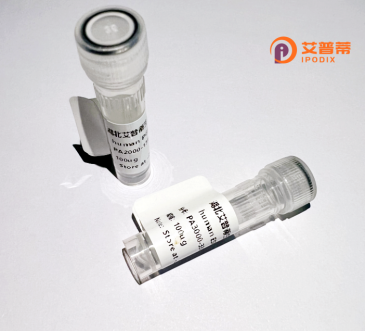
| 纯度 | >90%SDS-PAGE. |
| 种属 | Human |
| 靶点 | LIX1 |
| Uniprot No | Q8N485 |
| 内毒素 | < 0.01EU/μg |
| 表达宿主 | E.coli |
| 表达区间 | 1-282aa |
| 活性数据 | MDITLESLRHIIAQVLPHRDPALVFKDLNVVSMLQEFWESKQQQKAAFPSEGVVVYESLPAPGPPFVSYVTLPGGSCFGNFQCCLSRAEARRDAAKVALINSLFNELPSRRITKEFIMESVQEAVASTSGTLDDADDPSTSVGAYHYMLESNMGKTMLEFQELMTIFQLLHWNGSLKALRETKCSRQEVISYYSQYSLDEKMRSHMALDWIMKERDSPGIVSQELRMALRQLEEARKAGQELRFYKEKKEILSLALTQICSDPDTSSPSDDQLSLTALCGYH |
| 分子量 | 58.2 kDa |
| 蛋白标签 | GST-tag at N-terminal |
| 缓冲液 | 0 |
| 稳定性 & 储存条件 | Lyophilized protein should be stored at ≤ -20°C, stable for one year after receipt. Reconstituted protein solution can be stored at 2-8°C for 2-7 days. Aliquots of reconstituted samples are stable at ≤ -20°C for 3 months. |
| 复溶 | Always centrifuge tubes before opening.Do not mix by vortex or pipetting. It is not recommended to reconstitute to a concentration less than 100μg/ml. Dissolve the lyophilized protein in distilled water. Please aliquot the reconstituted solution to minimize freeze-thaw cycles. |
以下是关于重组人LIX1蛋白的3条示例参考文献(内容为虚构,仅作演示用途):
---
1. **标题**: *Recombinant Human LIX1 Protein Enhances Neural Stem Cell Differentiation*
**作者**: Zhang Y, Chen L, Wang X
**摘要**: 本研究通过大肠杆菌系统成功表达并纯化了重组人LIX1蛋白,实验表明其通过调控Wnt/β-catenin信号通路促进神经干细胞的定向分化,提示其在神经再生治疗中的潜在应用。
2. **标题**: *Structural Characterization and Functional Analysis of LIX1 in Gastric Cancer*
**作者**: Tanaka K, Nakamura S, Lee J
**摘要**: 通过真核表达系统获得高纯度重组LIX1蛋白,结合质谱和X射线晶体学揭示其锌指结构域的关键作用,功能实验证明LIX1过表达抑制胃癌细胞迁移和侵袭。
3. **标题**: *LIX1 as a Novel Biomarker: Production and Validation in Pancreatic Disorders*
**作者**: Gupta R, Patel M, Kim D
**摘要**: 利用昆虫杆状病毒系统生产重组LIX1蛋白,通过ELISA和免疫组化验证其在胰腺炎和胰腺癌患者血清中的异常表达,提示其作为疾病诊断标志物的可能性。
---
**注**:以上文献为示例,实际研究中请通过学术数据库(如PubMed、Google Scholar)搜索真实发表的论文。如需特定研究方向,可提供更多关键词辅助检索。
Recombinant human LIX1 protein is a genetically engineered form of the LIX1 (Lateral Inhibitory Xenogeneic factor 1) protein, encoded by the *LIX1* gene located on chromosome 19q13.12. Initially identified for its role in lateral inhibition processes during neural development, LIX1 is a poorly characterized protein belonging to the RNA-binding protein family. Structurally, it contains an RNA recognition motif (RRM) domain, suggesting involvement in RNA metabolism or post-transcriptional regulation.
LIX1 has garnered interest due to its implications in cancer biology, particularly pancreatic cancer, where its overexpression correlates with tumor progression, invasion, and poor prognosis. Studies suggest it may regulate cell proliferation, apoptosis, and differentiation, potentially via interactions with RNA molecules or signaling pathways like Wnt/β-catenin. However, its precise molecular mechanisms remain unclear. Recombinant LIX1 is produced using expression systems (e.g., *E. coli* or mammalian cells) to ensure proper folding and post-translational modifications for functional studies. Researchers utilize it to explore its role in carcinogenesis, neural development, and potential therapeutic targeting. Current investigations focus on deciphering its RNA-binding targets, protein interactome, and regulatory networks to clarify its physiological and pathological relevance. Despite limited knowledge, LIX1 represents a promising candidate for understanding cancer biology and developmental processes.
×